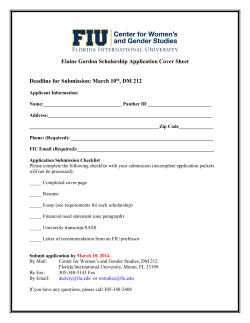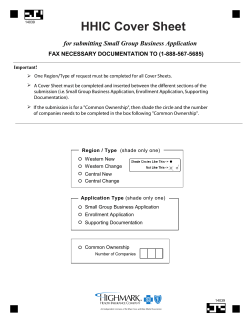
AMSF SAMPLE SUBMISSION REQUIREMENTS How do I submit a sample?
AMSF SAMPLE SUBMISSION REQUIREMENTS How do I submit a sample? To submit a sample to the AMSF, fill out a submission form (http://ms.fiu.edu/forms/) by providing as much information as you can. Note that PI signature and account number are required for FIU users. For external users a quote will be provided upon request. Attach your sample to the submission form and leave the sample with the submission form in the inbox in CP-174 (or in the refrigerator/freezer for temperature sensitive samples). If you are sending samples from outside the university please contact us regarding proper procedures and handling. When will my sample be run? Samples will be run in the order they are received, with priority given to samples from FIU researchers. Samples for each type of analysis will be run on the days specified by the schedule posted in CP-174. Samples must be received prior to the scheduled analysis time. For 9:00 AM-12:00 PM service times, the sample should be received before 9:00 AM. For 1:00-4:00 PM service times, the sample should be received before noon. Samples submitted after these deadlines may not be run until the next scheduled analysis time. Can I submit a sample from outside FIU? We accept samples from other universities, government and private institutions. However, priority is given to samples submitted from within the FIU research community. How much does MS analysis cost? Pricing is arranged according to the MS service requested. Most pricing is per sample for a given analysis. Please refer to our list of services and fees. How will I be charged for MS services? FIU users: If you are associated with FIU, you can use your FIU accounts (research grants and others) or contact your department chair to provide an account number to be used. non-FIU users: If you are sending a sample from outside FIU, we will generate a quote. Once written approval (email is sufficient) or a PO is received, an invoice with the payment instructions will be provided. For more details please contact us. How should I send samples from outside FIU? Samples should be mailed to: Please include a completed submission form and notify AMSF personnel when to expect your samples to arrive. Sample Preparation Guidelines ATTN: AMSF Facility FIU-Dept. of Chem. and Biochem. Scientific Receiving CP-193 11200 SW 8th Street Miami, FL 33199 Sample preparation plays a critical role in obtaining high-quality MS data. MS quality decreases as impurities, contaminants or matrices in your sample increase. The presence of salts and detergents, improper solvent choice, or improper analyte concentration are examples of sample preparation conditions which may adversely affect the MS data that can be obtained. We have summarized some of the things that you should consider before submitting your sample for MS analysis. In what form should I submit my sample? Samples can be submitted in solid, liquid, or solution form. What do I do with samples that need special storage or treatment? Light sensitive: Samples that are sensitive to light can be placed in a vial wrapped in aluminum foil. Low temperature storage: If a sample needs to be kept at low temperatures (refrigeration or freezing), please find an AMSF staff member or place it in one of the trays in the refrigerator or freezer. Air sensitive: Samples that are air sensitive or decompose quickly need special attention. Please contact AMSF staff in advance to make arrangements before submitting the sample. Acid/base sensitive: Some samples can degrade if an acid or base is added to the sample. If you are submitting a sample that is sensitive to acid to base, please indicate so. How much sample do I need to submit? The amount of sample required depends on the mass spectrometry service to be performed. In general, 1 mL of a 10 ppm sample or 1 mg in solid form is enough for all applications. If you have a limited quantity of sample, please inform AMSF staff. What solvents can I use? Solvents such as water, methanol, acetonitrile, chloroform, tetrahydrofuran, and dichloromethane are generally accepted for MS analysis. Highly viscous samples such as DMSO and DMF should be avoided. If you are submitting a sample in solution, on the submission form you should indicate the solvent that your sample is dissolved in and other solvents in which your sample is soluble. Samples can also be submitted in MS-compatible buffers for electrospray (ESI) or MALDI analysis. These buffers include ammonium acetate, ammonium formate, and ammonium bicarbonate at concentrations of 10 mM or less. MS-compatible acidic additives include acetic, formic, and trifluoracetic (TFA) acids. Avoid using salts, phosphate, HEPES, citrate or sulfate buffers, detergents (Tween, Triton, NP40, SDS), urea, glycerol, carbohydrates, EDTA, GnHCl, plastics and plasticizers, polyethylene glycols (PEG) or other polymers as these components will interfere with the ionization of your analyte. If you have salts or detergents in your sample, please contact AMSF staff. Some samples can be cleaned up using a Zip Tip (C4 or C18) to remove salts and buffers. There will be an additional charge for Zip Tip cleanup. FOR GC-MS Sample concentration and amount: 1 mg of sample is enough for pure solid, liquid, or oil samples. Solutions should be submitted not exceeding 1 mg/mL in a solvent suitable for GC-MS analysis. Solvents: GC-MS requires volatile organic solvents such as dicholormethane, hexane, methanol, ethyl ether, etc. GC-MS can not be performed directly on samples dissolved in water. Avoid: Some classes of compounds are not amenable to GC-MS analysis and should not be submitted for GC-MS analysis. These compounds include strong acids, strong bases, salts, water, metals, or polymeric material. Plastic vials and parafilm should also be avoided. FOR ESI: Sample concentration and amount: At least 0.1 mg of sample is needed for pure solid, liquid, or oil samples. Solutions should be 50 to 100 µM in a solvent suitable for ESI. We recommend a volume of ~1.5 mL at a concentration of 50 to 100 µM in a suitable ESI solvent but can perform analyses with as little as 100 µL of solution. Solvent: Suitable solvents for ESI include methanol, acetonitrile, and mixtures of water and acteonirtile or methanol. Samples are accepted in pure water, tetrahydrofuran and dichloromethane, however cannot be run directly from these solvents. Avoid: see above. FOR MALDI: Sample concentration and amount: For MALDI, the amount of sample will depend on the mass of your analyte. For masses between 500 and 2000, 0.1 mg is typically sufficient for pure solid, liquid, or oil samples. For higher masses, larger amounts of sample may be required, depending on the mass, purity, and type of sample. Solutions should be provided with at least 5 µL at a concentration of at least 100 µM. Solvent: Suitable solvents include water, methanol, dichloromethane, acetonitrile, and others. Avoid: See above What is unit mass or accurate mass? Which one should I request? Unit Mass: In unit mass or nominal, the mass is generally accurate to within few tenth of a Da. Mass spectrometers that are labeled as low resolution normally provide unit mass. We provide unit mass analysis for all samples submitted unless exact mass is requested. Accurate Mass: In exact or accurate mass measurement, mass is accurately determined to four decimal places using a high resolution mass spectrometer that is calibrated internally or externally, offering higher certainty in the identification of your compound. In order to request this service, analyte observation must first be verified by unit mass analysis. Accurate mass is only provided for samples submitted for ESI and/or MALDI analysis. We have two options for high resolution analysis: 10k and FTMS (>200k) and are priced accordingly. Do I need to provide a Chemical Structure? Yes, please provide us with a chemical structure and molecular formula for your analyte. The structure helps us to determine the ionization method and the formula allows us to interpret the MS data. DATA REPORTS When should I expect MS data? Typically we will try to provide a data report within 48 hours of when the sample was run. Where can I pick/receive my analysis result? You will receive an electronic copy of the report in pdf format sent to the email address provided on the submission form. If a printed report is desired, please contact AMSF staff in CP-174. Can I get an electronic copy of the MS data? We can provide a text file of the MS data for all researchers upon request. How long can my data be stored with the AMSF? Data will be stored by AMSF for a minimum of six months. It is your responsibility to obtain a copy of your data within this time frame. PUBLICATION What should we include in our experimental or results section? If you are writing a manuscript and would like to include data obtained by AMSF, please contact us so we can provide details regarding the MS analysis. Should we send our publication once it is accepted? If you publish a paper that includes data obtained by AMSF, it is mandatory that you send us a citation of the publication (or a PDF file when possible) once your work is published on the web. What are the rules or policy for publication or presentation of data obtained from AMSF? Research carried out in part or in full using AMSF services requires acknowledgement of the AMSF facility, facility and staff, or co-authorship. Sample submission implies agreement to this acknowledgment policy. A typical acknowledgement statement would be “Mass spectrometry related research reported in this publication was supported by the Advanced Mass Spectrometry Facility of Florida International University.”
© Copyright 2025





















